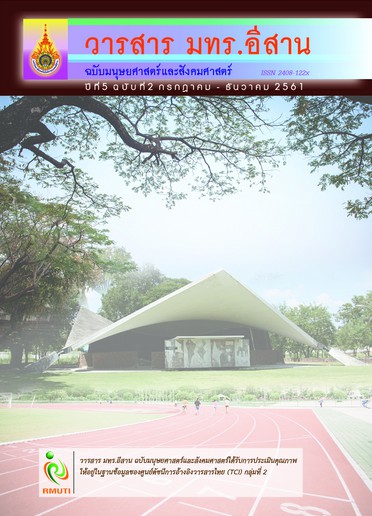การเสริมสร้างแรงจูงใจใฝ่สัมฤทธิ์ในการเรียนวิชาหลักการออกแบบและพัฒนาโปรแกรมโดยการจัดการเรียนรู้แบบร่วมมือร่วมกับเครือข่ายสังคมออนไลน์
Main Article Content
Abstract
Enhancing achievement motivation in learning program design and development based on cooperative learning with online social networks is an action research which aims at studying the results of learning activity development, comparing scores of pre and post - tests and comparing the achievement motivation of students in the Computer Engineering Department. The research applied the principles of program design and development of creating programming fl owchart according to the curriculum of the Bachelor of Science in Industrial Education Program in Computer and Technology. The samples used in the research were 21 students in the computer engineering department, the faculty of industrial education, who enrolled in the program design and development course in the fi rst semester of academic year 2017. The research tools were PAOR cycle according to the concept of Kemmis and McTaggart and online social networks such as Facebook and Kahoot. The statistical tools used in data analysis were mean, standard deviation and Wilcoxon signed-rank test. The results of the research found that the mean of the students’ pre-test scores was 14.62 and the standard deviation was 1.71. All students had higher scores in the post-test with a mean of 30.19 and a standard deviation of 0.52 had a total score of 40. After comparing the pre-test and post-test scores was signifi cantly diff erent at p < 0.05. When comparing the achievement motivation, it found that the achievement motivation for post-learning was higher than the motivation for pre-learning.
Article Details
บทความที่ได้รับการตีพิมพ์เป็นลิขสิทธิ์ของมหาวิทยาลัยเทคโนโลยีราชมงคลอีสาน
ข้อความที่ปรากฏในบทความแต่ละเรื่องในวารสารวิชาการเล่มนี้เป็นความคิดเห็นส่วนตัวของผู้เขียนแต่ละท่านไม่เกี่ยวข้องกับมหาวิทยาลัยเทคโนโลยีราชมงคลอีสานและคณาจารย์ท่านอื่นๆในมหาวิทยาลัยฯ แต่อย่างใด ความรับผิดชอบองค์ประกอบทั้งหมดของบทความแต่ละเรื่องเป็นของผู้เขียนแต่ละท่าน หากมีความผิดพลาดใดๆ ผู้เขียนแต่ละท่านจะรับผิดชอบบทความของตนเองแต่ผู้เดียว
References
จิราวรรณ พุ่มต้นวงษ์. (2553). การพัฒนาบทเรียนคอมพิวเตอร์ช่วยสอนผ่านเว็บ วิชาระบบฐานข้อมูลด้วยวิธีการจัดการเรียนรู้ แบบร่วมมือโดยใช้เทคนิคทีมแข่งขัน. ปัญหาพิเศษ สาขาวิชาเทคโนโลยีคอมพิวเตอร์ ภาควิชาคอมพิวเตอร์ศึกษา บัณฑิตวิทยาลัย มหาวิทยาลัยเทคโนโลยีพระจอมเกล้าพระนครเหนือ. กรุงเทพฯ
ชุติมา สัจจานนท์. (2550). การรู้สารสนเทศสู่การพัฒนาที่ยั่งยืน: แนวคิด ทฤษฎี มาตรฐาน การวิจัยและการปฏิบัติ. รายงานการประชุม เรื่อง “การรู้สารสนเทศของปวงชน: เรียนรู้เพื่อสังคมเศรษฐกิจพอเพียง” วันที่ 18 - 21 ธันวาคม 2550. สมาคมห้องสมุดแห่งประเทศไทย. กรุงเทพฯ
ซูฮัยลา สะมะแอ. (2559). รายงานวิจัยการพัฒนาทักษะการฝึกตรวจวิเคราะห์และประเมินสภาวะการสุขาภิบาลอาหาร: อาหารสะอาด รสชาติอร่อย. วิทยาลัยการสาธารณสุขสิรินธร จังหวัดยะลา สถาบันพระบรมราชชนก กระทรวงสาธารณสุข. ยะลา
ทิศนา แขมมณี. (2550). ศาสตร์การสอน: องค์ความรู้เพื่อการจัดกระบวนการเรียนรู้ที่มีประสิทธิภาพ. พิมพ์ครั้งที่ 6. ด่านสุทธาการพิมพ์. กรุงเทพฯ
มลาวัลย์ นกหงษ์. (2554). การเปรียบเทียบผลสัมฤทธิ์ทางการเรียน และความสามารถการคิดวิเคราะห์เรื่องโจทย์ปัญหาทศนิยม กลุ่มสาระการเรียนรู้คณิตศาสตร์ ชั้นประถมศึกษาปีที่ 6 ที่เรียนโดยการจัดการเรียนรู้แบบร่วมมือ และการจัดการเรียนรู้ตามคู่มือครู สสวท. วิทยานิพนธ์มหาบัณฑิต สาขาวิชาวิจัยและประเมินผลการศึกษา คณะครุศาสตร์ มหาวิทยาลัยราชภัฏเลย. เลย
สำนักงานคณะกรรมการการศึกษาแห่งชาติ. (2545). พระราชบัญญัติการศึกษาแห่งชาติ พ.ศ. 2542 และที่แก้ไขเพิ่มเติม (ฉบับที่ 2) พ.ศ. 2545 และ (ฉบับที่ 3) พ.ศ. 2553. พริกหวานกราฟฟิค จำกัด. กรุงเทพฯ
สำนักงานเลขาธิการสภาการศึกษา กระทรวงศึกษาธิการ. (2560). แผนการศึกษาแห่งชาติ พ.ศ. 2560 - 2579. พริกหวานกราฟฟิค จำกัด. กรุงเทพฯ
สิริเกศ หมัดเจริญ และน้อยทิพย์ ลิ้มยิ่งเจริญ (2554). การพัฒนาความสามารถในการแก้ปัญหาและผลสัมฤทธิ์ทางการเรียนวิชาฟิสิกส์ เรื่อง เสียงของนักเรียนชั้นมัธยมศึกษาปีที่ 5 โดยใช้กลวิธีเมตาคอกนิชัน. วารสารศึกษาศาสตร์ ฉบับวิจัยบัณฑิตศึกษา. ปีที่ 5, ฉบับที่ 4, หน้า 94-101
สุพิชชา ตันติธีระศักดิ์ และศิวนิต อรรถวุฒิกุล. (2559). ผลของการจัดกิจกรรมการเรียนแบบผสมผสานผ่านเครือข่ายสังคมออนไลน์ตามแนวคิดเพื่อนช่วยเพื่อน เพื่อส่งเสริมทักษะการแก้ปัญหาการเขียนโปรแกรมของนักเรียนระดับชั้นมัธยมศึกษาปีที่ 5. Veridian E-Journal, Silpakorn University ฉบับภาษาไทย มนุษยศาสตร์สังคมศาสตร์และศิลปะ. ปีที่ 9, ฉบับที่ 3, หน้า 1081-1093
Bersin and Associates. (2003). Blended Learning: What works? An industry study of the strategy, implementation, and impact of blended learning. Oakland, CA: Bersin & Associates.
Bujea, Eleanor and Stanley Voyce. (1988). Teaching Computing: A Practical Approach. New Jersey: Prentice Hall.
Conbach, L. J. (1984). Essential of Psychology and Education. New York: Mc-Graw Hill
Dickerson, D. P. (1976). A Comparison of the use of the Active Games Learning Medium with Passive Games and Traditional Activities as Means of Reinforcing Recognition of Selected Sight Vocabulary Words with Mid-Year First-Grade Children with Limited Sight Vocabulary. Dissertation Abstracts International. 10: 6456-A; April
Kemmis, S. and McTaggart, R. (1988). The Action Research Planer (3rd ed.). Victoria: Deakin University, Australia
Steinfi eld, C., Ellison, N., and Lampe, C. (2008). Social Capital, Self-Esteem, and use of Online Social Network Sites: A Longitudinal Analysis. Journal of Applied Developmental Psychology. Vol. 29, Issue 6, pp. 434-445. DOI: 10.1016/j.appdev.2008.07.002
Wodarski, L. A., Adelson, C. L., Todd, M. T., and Wodarski, J. S. (1980). Teaching Nutrition by Teams-Games-Tournaments. Journal of Nutrition Education. Vol. 12, Issue 2, pp. 61-65. DOI: 10.1016/S0022-3182(80)80036-7

